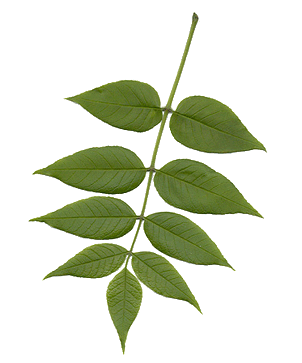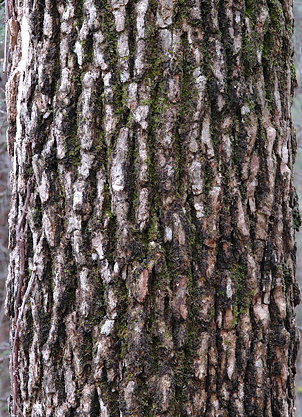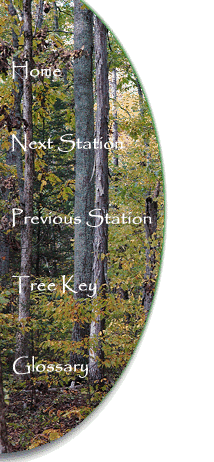| |
|
| |
 |
| |
Blue Ash Leaf |
Identification:
Look for the fallen leaves on the ground beneath the station tree.
The leaves are pinnately
compound, smooth above and paler and hairy
below. The 7 to 11 leaflets are 3 inches
to 5 inches long and stalked. The
leaflet
margins are
serrate. The leaves are 8
inches to 12 inches in length. Compare these leaves to those
of the White Ash. Note the opposite branching pattern of this
tree.
| |
|
 |
|
|
Blue Ash Bark |
The bark of the Blue Ash is bluish
gray to brown-gray, and is thick-furrowed with interlacing ridges.
As the tree ages the bark becomes scaly, then shaggy.
| |
|
| |
 |
| |
Blue Ash Twig |
The twigs of the Blue Ash are very
distinctive in that the young twigs are square in cross-section.
Compare the twigs with those of the White Ash, which are round in
cross section. The twigs are stout, light green to gray,
either smooth or slightly hairy.
Leaf scars are notched at the
bud. The terminal bud is 1/4 inch long, gray to reddish brown
and hairy. The lateral buds are similar but smaller.
Other Uses
and Lore:
The Blue Ash takes
its common name from the fact that twigs or inner bark immersed in
water will turn water blue. In fact the pioneers used the twigs and
bark to make a blue dye. The species name, quadrangulata,
refers to the four-sided twigs (see image on previous page). The
wood is heavier than white ash, and is very strong and
course-grained. It is used for rough construction, fence posts, and
for handles for spades, shovels and similar tools. It is a common
lumber for cabinetry and furniture.
A variety of
wildlife eat the seeds, including eastern gray squirrel, eastern
cottontail and white-tail deer.
The
Trail From Station Eight to Station Nine
 |
| Red-breasted
Nuthatch |
From Station
Eight, the trail continues to descend toward the river, but not as
steeply as before. The limestone outcroppings so prominent
earlier along the trail are absent now. Look and listen
for winter visitors like the Red-breasted Nuthatch. How often
you see this species varies from winter to winter, but they can be
fairly common. Station Nine will be on the right side of the
trail.
|

